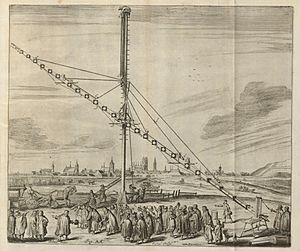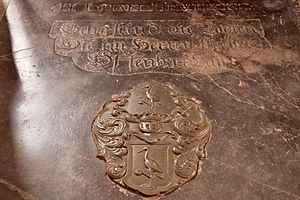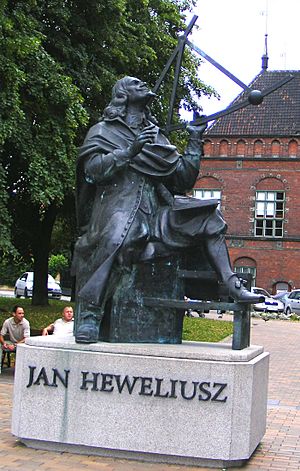Johannes Hevelius facts for kids
Quick facts for kids
Johannes Hevelius
|
|
|---|---|
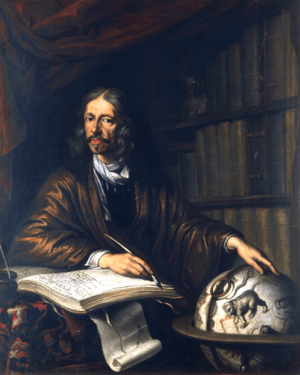
Portrait by Daniel Schultz
|
|
| Born | 28 January 1611 |
| Died | 28 January 1687 (aged 76), Gdańsk, Polish–Lithuanian Commonwealth
|
| Alma mater | Leiden University |
| Known for | Lunar topography |
| Scientific career | |
| Fields | jurisprudence, astronomy, brewing |
Johannes Hevelius (born January 28, 1611 – died January 28, 1687) was a famous astronomer from Gdańsk. At that time, Gdańsk was part of the Polish–Lithuanian Commonwealth. Hevelius was also a city councilor and even a mayor of Gdańsk.
He is often called the "founder of lunar topography." This means he created the first detailed maps of the Moon's surface. He also discovered ten new groups of stars, called constellations. Seven of these constellations are still used by astronomers today!
Contents
Early Life and Education
Johannes Hevelius was born into a wealthy family in Gdańsk. His parents were Abraham Hewelke and Kordula Hecker. They were German-speaking Lutherans who made their money as brewers.
When he was young, Hevelius studied the Polish language in a town called Gądecz. After finishing secondary school, he went to Leiden University in 1630. There, he studied law. Hevelius then traveled to England and France. During his travels, he met other important scientists like Pierre Gassendi.
In 1634, he returned to Gdańsk. He married Katharine Rebeschke in 1635. The next year, he joined the beer-brewing guild. He even became its leader in 1643. Hevelius was known for brewing a famous beer called Jopen.
Hevelius's Astronomy Work
Even though he was involved in city government, Hevelius's main passion was astronomy. From 1639 onwards, he spent most of his time studying the stars.
His Amazing Observatory
In 1641, Hevelius built an observatory on the roofs of his three connected houses. He filled it with amazing instruments. One of his most famous tools was a very long telescope. It was about 150 feet (46 meters) long! He built its wooden and wire tube himself. This observatory was known as Sternenburg, which means "Star Castle."
Many important people visited his observatory. The Polish Queen Marie Louise Gonzaga visited in 1660. Hevelius also had the support of four Polish kings. King John II Casimir Vasa even visited his observatory in 1659. The king made Hevelius's family part of the nobility in 1660. Later, King John III Sobieski helped Hevelius by letting him sell his beer freely.
Meeting Edmond Halley
In 1679, a young English astronomer named Edmond Halley visited Hevelius. Halley was sent by the Royal Society of London. Hevelius had been a member of this famous scientific group since 1664.
Halley wanted Hevelius to use telescopes for his measurements. But Hevelius showed that he could make very accurate observations using only tools like a quadrant and an alidade. Hevelius is known as the last major astronomer to do important work without using a telescope.
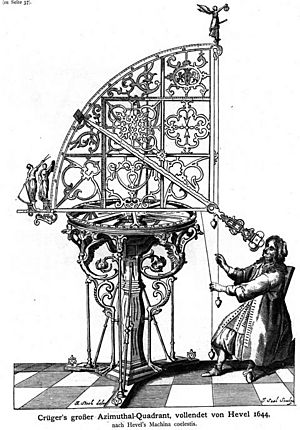
Key Discoveries and Publications
Hevelius made many important discoveries. He observed sunspots from 1642 to 1645. He spent four years mapping the Moon's surface. He also discovered the Moon's "libration," which is a slight wobble in its movement. He published his detailed maps and findings in a book called Selenographia in 1647. This book earned him the title "founder of lunar topography."
Hevelius also discovered four comets in 1652, 1661, 1672, and 1677. He believed that comets travel around the Sun in curved paths.
Elisabeth Hevelius: The First Female Astronomer
Johannes Hevelius's first wife, Katharine, passed away in 1662. A year later, he married Elisabeth Koopmann. She was the daughter of a merchant family. Elisabeth helped her husband with his astronomy work. After his death, she even published two of his books. Elisabeth is considered one of the first female astronomers in history.
Fire and Recovery
On September 26, 1679, a terrible fire destroyed Hevelius's observatory. All his instruments and books were lost. He wrote about this disaster in his book Annus climactericus (1685).
Even after such a loss, Hevelius quickly repaired enough of his observatory to continue his work. He was able to observe a great comet in December 1680. To remember his lost instruments, he named a new constellation Sextans, after a sextant, which is an astronomical tool.
New Constellations
In 1683, Hevelius created and named another constellation. He called it Scutum Sobiescianum (Sobieski's Shield). He did this to honor the victory of Christian forces led by Polish King John III Sobieski at the Battle of Vienna. This constellation is now simply called Scutum.
Hevelius included this constellation in his star atlas, Firmamentum Sobiescianum. He printed this large book in his own house and even engraved many of the printing plates himself.
Johannes Hevelius passed away on his 76th birthday, January 28, 1687. He was buried in St. Catherine's Church in Gdańsk.
Works
Here are some of the important books and works by Johannes Hevelius:
- Selenographia (1647): This book contained his detailed maps of the Moon.
- Historiola Mirae (1662): In this work, he named the variable star Omicron Ceti "Mira" (meaning "the Wonderful").
- Mercurius in Sole visus Gedani (1662): This book was mainly about the planet Mercury passing in front of the Sun.
- Cometographia (1668): A book about comets.
- Machina coelestis (first part, 1673): This book described his astronomical instruments. The second part was mostly destroyed in the 1679 fire.
- 'Annus climactericus, sive rerum uranicarum observationum annus quadragesimus nonus at Google Books (1685): This book described the fire of 1679 and included more observations.
- Prodromus Astronomiae (published around 1690): This was an unfinished work published after his death by his wife, Elisabeth. It included:
See also
 In Spanish: Johannes Hevelius para niños
In Spanish: Johannes Hevelius para niños
- Polish Navy Ship ORP Heweliusz
- Polish ferry MS Jan Heweliusz, which sank in 1993
- Hevelius (crater), a crater on the Moon named after him
- 5703 Hevelius, an asteroid named after him
- Heweliusz, a Polish astronomy satellite launched in 2014


